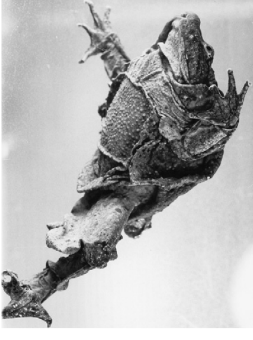![]() This is a follow-up on yesterday’s post, which discussed a lungless frog species recently discovered on Borneo. Victor H. Hutchison has written a comment in the journal Current Biology that highlights a few interesting concepts.
This is a follow-up on yesterday’s post, which discussed a lungless frog species recently discovered on Borneo. Victor H. Hutchison has written a comment in the journal Current Biology that highlights a few interesting concepts.
Sometimes I give an introductory lecture on the histology of the human lung to undergraduates in our department. I invariably start off by asking the students what the organ is good for, and I always get the same two answers: Gas exchange and barrier function. I never realised that there is a third function in many animals, although it’s obvious when you think of it: flotation. As a submarine can regulate its buoyancy by filling tanks with either water or air, so can many amphibians regulate theirs with their lungs.
Hutchison explains that amphibians may be particularly susceptible to losing their lungs because they have rather inefficient breathing dynamics. Apparently, they cannot breathe by changing the volume of the thorax with muscles, like we do. Instead, thay have to force air into the lungs by a swallowing motion. Then, because of the higher pressure built up in the lungs, expiration takes place when they open their mouths again. Further factors that contribute to the redundacy of lungs are a higher body surface area to volume ratio, a permeable skin with capillaries growing into the epidermis (unlike ours, which stop in the underlying dermis), and low metabolic rates due to cold temperatures.
A unifying trait for the previously known lungless salamanders and the recently discovered lungless frog is that they live in cold streams. Hutchison therefore proposes that the loss of lungs helps keep these animals on the bottom, preventing them from being swept away by the water. He does not mention that gas exchange will be much more efficient in moving water than in a still-standing pond, but this seems an obvious observation to me.
Some amphibians have reduced lungs while still retaining the capacity to use them. One example is the Titicaca frog (Telmatobius culeus). This animal lives in high-altitude waters in the Andean mountains. Normally, these frogs stay underwater and use their many skin folds for gas echange. These folds have very superficial blood vessels and are ventilated by a “bobbing” motion. In addition, the frog’s blood is very rich in hemoglobin.

Titicaca frog. Image from Hutchison's paper.
Hutchison remarks that there are probably more lungless frog species with specimens sitting around in museums of natural history, that have never been dissected. Perhaps these museums would be helped by a small CT scanner? (More likely perhaps, they would be helped by people with an interest in going through their vast collections and cataloguing them.)
Full reference:
HUTCHISON, V. (2008). Amphibians: Lungs’ Lift Lost Current Biology, 18 (9) DOI: 10.1016/j.cub.2008.03.006